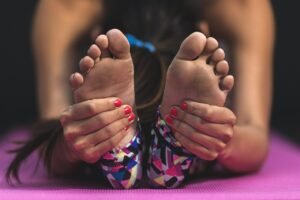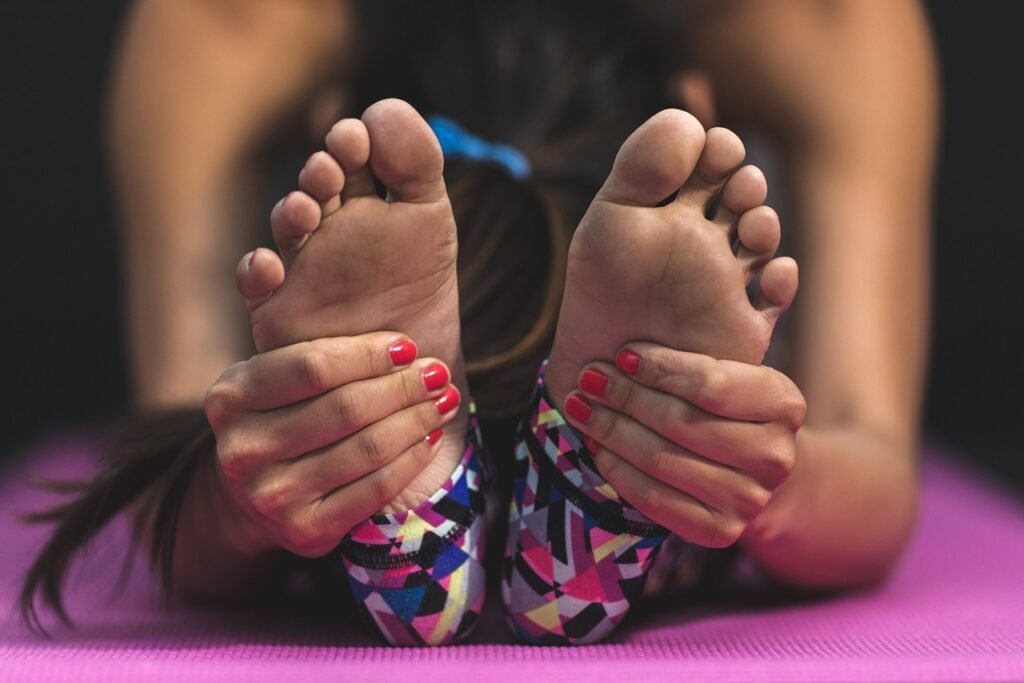Leg press is a well-known and effective lower body workout that is used by many people to increase strength and build muscles on the legs. But, what is often under the radar is the vital role of foot positioning in determining the effectiveness and safety of the exercise. This article will examine the complex relationship between foot placement and leg press.

Understanding the Leg Press Exercise
Before we go into the details of foot placement, we’ll take a moment to understand how to perform the exercise leg presses. It requires you to use your legs muscles to push a platform with a weight off your back. The muscles most targeted by a leg press include the quadriceps, hamstrings and glutes.
Importance of Proper Foot Placement

The Basics of Foot Positioning
A proper foot placement is crucial for the success of a leg press. The feet should be spaced shoulder-width apart with your feet lying flat on the platform and slightly pointing towards the outside. This position helps distribute the weight evenly and ensures equilibrium.
Effect on Targeted Muscle Groups
Proper foot placement will ensure that you can effectively work the targeted muscles. Correct foot placement can focus certain muscle groups, allowing you to concentrate the fitness objectives you want to achieve, such as hypertrophy, strength or endurance.
Common Foot Placement Mistakes
Feet Too High on the Platform
The way you position your feet could strain your lower back and cause it to not be effective in engaging the muscles of your legs.
Feet Too Low on the Platform
However the fact that your feet are too low will limit your movement range and could cause less muscle stimulation.
Feet Too Wide Apart
A proper foot placement can stress your hips and decrease stability, thereby increasing the chance of injuries.
Feet Too Close Together
In the opposite, keeping your feet too close to each other could cause instability, which can limit the efficiency of the workout.
The Ideal Foot Placement
Feet Hip-Width Apart
The optimal foot position for most people is hip width to each other. This ensures stability, balance and a full range of movement.
Toes Pointed Slightly Outward
The slight tilt of your toes inward helps reduce knee strain and ensures that effort is distributed evenly throughout the leg muscles.
The Impact on Joint Health
A proper foot position is beneficial to muscle mass and play an important part for maintaining the health of joints particularly around the hips and knees.
Balancing Weight Distribution
Avoiding Excessive Toes or Heel Dominance
The balance of your weight distribution between your heels and toes is crucial. Over-reliance on one can cause pain and injuries.
Foot Placement Variations for Different Goals
Leg Press for Strength
In case strength and endurance is the main objective, then you can choose a more extensive foot positioning to engage many muscle groups simultaneously.
Leg Press for Hypertrophy
To increase the purpose of hypertrophy (muscle growth) focus on a controlled movement using the hip width that is standard is more efficient.
Leg Press for Endurance
The use of narrower positions can aid endurance training as they improve the amount of time you are under tension.
The Role of Foot Placement in Injury Prevention
Proper foot positioning minimizes the chance of injury when you press your leg, like strains, sprains, and joint issues.
Proper Form and Technique
Foot placement is only one element of good technique and form. Maintaining an upright spine, balancing the weight and breathing properly are equally important.
Leg Press Foot Placement, Foot Placement on Leg Press
To build more strong and well-defined legs The leg press machine can be a useful ally on your fitness routine. But, getting the best results doesn’t just mean lifting weights. It’s all about leg press foot positioning and the specifics of how to position your feet to get the most effective results. In this thorough guide, we’ll go over the nuances of foot placement on a leg press machine, making sure that you reap the maximum benefit of your daily leg workout.
Why Foot Placement Matters?
The location the position of the position of your legs on the press machine has a significant impact on the muscles you work during your workout. It influences the movement range, the degree of comfort, as well as the possibility of injuries. To maximize your advantages and reduce the risk making sure your foot is placed correct is essential.
The Basics of Foot Placement
Hip-Width Stance
Begin by taking a stance that is hip-width. This allows your feet to align to your hips and provides an enduring base. This is the basic posture for the majority of lifters.
Toes Pointing Forward
Keep your toes pointed towards the forward. This ensures that you are pushing the weight evenly across both legs, which reduces the possibility for muscle imbalances.
Foot Position on the Platform
Put your feet upon the surface. Make sure that your whole foot is on the platform so that the load is distributed equally.
Foot Placement Variations
Body type and your fitness level may determine your foot’s position. Let’s take a look at the most commonly used variations.
Narrow Stance
A stance that is narrow targets the quads outside, while adding definition to your thighs. legs.
Wide Stance
A wider stance, on the other hand, can shift the focus away from the hamstrings and inner quads and hamstrings, which can help develop them.
High in comparison to. Lower on the Platform
The higher your feet are placed on the platform accentuates your glutes whereas the lower position of your feet focuses on your quads.
Effects on Muscle Targeting
Understanding how foot position influences muscle focusing is crucial to ensure a leg workout that is effective.
Quadriceps Emphasis
The proper foot position will increase the quadriceps’ involvement which will result in more significant front thigh muscle development.
Hamstring and Glute Activation
Different foot positions can encourage glute and hamstring activation and help to create a more balanced lower body.
Common Mistakes to Avoid
In order to ensure your safety and efficiency to ensure your safety, be aware of these common positioning errors, including placing them too high, or far off the floor.
Foot Placement for Beginners
If you’re new to leg press, start by using an incline of hip width and then adjust as you get more comfortable and familiar.
Foot Placement for Advanced Lifters
Experiment with various foot positions in order to specifically target muscles and break through plateaus.
Foot Placement for Rehabilitation
Ask a fitness expert in order to establish the best position for your feet when recuperating from injury.
The Role of Comfort and Safety
Security and comfort must always be top of mind. The feeling of discomfort and pain when pressing your legs could be a sign of improper foot positioning.
Tips for Achieving Proper Foot Placement
Follow these steps to ensure your foot positioning is in line with the fitness objectives you have set and your your body type.
Sample Leg Press Workouts
Here, we have provided examples of leg press exercises to aid you in putting your new skills into practice.
Incorporating Variety
Variation is essential to continue advancement. We’ll talk about how you can include foot placement changes in your daily routine.
Conclusion
In the realm of fitness it is all about the details, and the foot position during leg presses is no different. Proper foot placement can make the difference between a safe and effective exercise and one that doesn’t meet your objectives. Therefore, the next time you are at the fitness center, be sure to pay careful pay attention to the position of your feet on the Leg Press platform. Your joints and muscles will appreciate it.
FAQs
What is the best time to incorporate leg exercises in my fitness routine?
The duration of your leg press exercises is dependent on the fitness routine you follow. A couple of times per week is sufficient but the frequency varies between individuals.
Do you be uncomfortable during exercises for leg strength?
There are times when discomfort can be normal, particularly during intensive exercise. However, any pain or sharp symptoms should be treated with care and treated accordingly.
Does foot position influence my posture?
A wrong foot position can affect your posture when you leg presses and, in time, could impact your posture in general.
Are alternatives for the press on your legs to increase leg strength?
Yes, alternative exercises such as squats, lunges and step-ups are also a great way to increase the strength of the muscles in your legs.
Do I have to talk with an instructor for customized guidance?
If you’re just beginning to master the leg press, or have goals for your fitness getting a fitness coach is a good idea. They can make sure you’re employing the right foot placement and technique.
What are different foot positions on leg presse accomplish?
Different feet positions during the leg press will target different muscles. A more expansive stance highlights the adductors and thighs in the inner thighs and adductors, while a more narrow perspective focuses upon the quadriceps. A high foot position works the on hamstrings, while low foot position puts the pressure on the glutes.
Do you want your feet to be high or low when you press your legs?
The best foot position for your leg presses is high or too low. Place your feet hip-width apart to ensure balance and proper muscle engagement.
Is it important to know the place you put your pressure on your leg?
It’s true, it’s crucial. The balance of weight distribution evenly across your heels and toes is essential for stability and preventing injury in the leg press.





